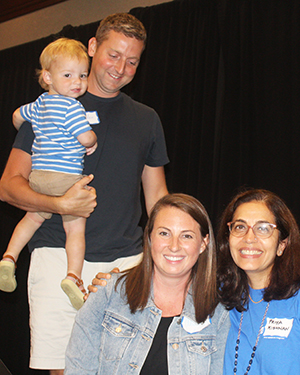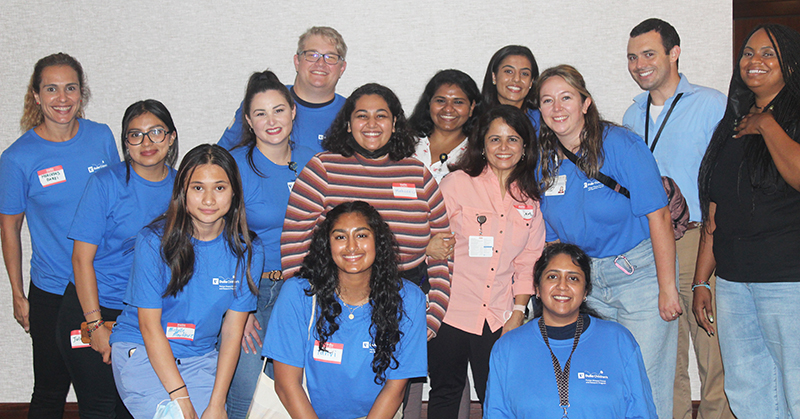
Duke Continues to Take Extraordinary Measures to Treat Pompe Disease
Dozens of kids scamper around with freshly painted faces, balloon animals in hand, smiling, laughing, and playing. Parents, chatting with one another, keep close eyes on their little ones, who, for the moment, appear to not have a care in the world. The room is alive with joy and camaraderie.
This whole scene is possible only because of years of dedicated work by Duke University School of Medicine researchers.
Dozens of families — nearly 150 people altogether — gathered in Durham in August, united by a common thread: Pompe disease. The 11th annual Pompe Patient Meeting, hosted by the Duke University Pompe Disease Clinical and Research Team, has become a sort of homecoming and network of hope for these families so deeply affected by the advances Duke has made in helping children and adults with Pompe disease live longer, fuller lives.
Pompe disease, also known as Glycogen Storage Disease Type II, is a rare genetic disease that occurs when the body can’t produce enough — or, in some cases, any — of the enzyme acid alpha-glucosidase (GAA). Without GAA, glycogen, a complex sugar, builds up in the body and damages muscles, including the heart and other organs and leads to tissue degradation, respiratory problems, heart failure, and death. Until relatively recently, most infants and young children diagnosed with Pompe disease had a life expectancy of no more than a year or two.
That has changed, and Duke has led the way in researching and treating Pompe disease. Pediatric geneticist Y.T. Chen, MD, PhD, professor emeritus of pediatrics, began working on a treatment option in the 1990s. He engineered a cell line that could make GAA, which went into clinical trials in 1999, with Priya Kishnani, MD, chief of the medical genetics division at Duke and the Chen Family Distinguished Professor of Pediatrics, leading the efforts.
In 2006, Myozyme, the enzyme replacement therapy (ERT) created in Chen’s lab, became the first FDA-approved treatment for Pompe disease, and remains the only treatment for infantile Pompe disease. By injecting patients with genetically engineered GAA, their bodies can break down glycogen before it builds up. In many cases, the therapy can even reverse damage to the heart.
Prior to this breakthrough, there were no available treatment options for Pompe: “We told parents to love the baby,” Kishnani said, “because they would likely not live to their first birthday.”
A Journey Through Time
This year’s Pompe Patient Meeting was a reunion of sorts after the COVID-19 pandemic put a two-year pause on in-person gatherings. During that time, additional new therapies have been approved, and more states — now 32 and Washington, D.C. — have made screening for Pompe disease standard for newborns.

For the Breitbarth family, newborn screening saved their son’s life. “Thanks to Grant’s newborn screening diagnosis and his early treatment, he is thriving,” mom Alison Breitbarth said. She and her husband are now dedicated advocates for newborn screening for Pompe disease in every state. “Every baby deserves the chance our son has gotten.”
The Pompe Patient Meeting took attendees on a journey through time. “I wanted families — old and new — to have a good understanding of where we are today,” Kishnani said.
While returning families know firsthand what the journey has been like through the years, the meeting helped bring them up to date on the newest breakthroughs and developments, like a method to test and diagnose the disease in-utero and begin treatment before birth, which is currently in clinical trials through a collaboration between Duke and the University of California, San Francisco.
The earlier treatment is initiated for Pompe disease, the better the outcomes for the patients. “You can only rescue so much,” Kishnani said. “But if you start in time and are aggressive with management and next generation therapies, we expect continued benefit.”
Many of the recent advances in diagnosing and treating Pompe disease have come in no small part from research studies and clinical knowledge gained through the families who have been grappling with this disease for years. “Their contributions to research are what brought us to where we are today,” Kishnani said.
A Message of Hope
A disease that can rob a baby of its life after only a year is now treatable, and while there is still no cure, treatment can prolong life by decades.
“The entire Duke team has championed this together from every perspective -- from drug therapy, nutrition, physical therapy, speech therapy, understanding the pathophysiology and biomarkers, and immunology, to name a few,” Kishnani said.
Patients diagnosed as babies are growing up and thriving. Some shared their experiences at the meeting.
Stella, a 13-year-old who was diagnosed with Pompe disease at nine weeks, loves to read, create art, swim and go horseback riding. She has a strong network of friends she can count on. “My friends really understand me and include me in everything they do,” she said.
Her mom, Jaqueline, spoke at the meeting about Victory Junction, a camp designed for kids with illnesses or disabilities where they can just be kids. Stella has been going for years and enjoys things like arts and crafts, woodshop, archery, ziplining, and participating in talent shows. “It’s my favorite camp ever,” Stella said.
Stella admits that sometimes having Pompe disease is hard, but it was important for her to share that “you can still do things that other people do if you put your mind to it. And if you can’t, that’s okay. Maybe you can modify so you can do it.”
When Stella grows up, she wants to be a nurse who administers ERT to others with Pompe.
Other patient speakers talked about starting college, planning for their master’s degrees, and pursuing careers that will allow them to help others.
“They are doing things that all of us hoped they’d be able to do and that we know they are capable of doing,” Kishnani said.
Hope is also what propels the researchers, coordinators, technicians, assistants behind the scenes in the lab, physical and occupational therapists, speech specialists, and students and trainees to come together to further the progress of understanding and treating Pompe disease.
“It’s gratifying and very humbling,” Kishnani said. “To me, the journey puts into perspective why we do what we do.”

The Work Continues
Enzyme replacement therapy and newborn screening have given patients with Pompe disease a chance at life, but ERT doesn’t work for everyone.
For some patients, ERT triggers an immune response, causing their bodies to produce antibodies to fight off the foreign enzyme. Immune suppressing drugs can help combat the immune response, but that comes at a cost: the increased risk of infection.
Duke is currently involved in clinical trials to introduce gene therapy into the arsenal of treatment options. Instead of injecting the missing enzyme, gene therapy would deliver a functional version of the gene responsible for producing GAA. In lieu of biweekly ERT injections, gene therapy would involve a single infusion for long-lasting effects.
Great progress has been made against Pompe disease, but researchers and clinicians remain driven by the possibility of still greater advances.
As Y.T. Chen told Kishnani years ago, “Where there’s passion, there’s always a way forward.”
Alissa Kocer is the communications strategist for the Duke Precision Genomics Collaboratory.
Main Photo: Priya Kishnani, MD, chief of the medical genetics division at Duke University School of Medicince, led research to develop life-changing treatment for those with Pompe Disease. Photo by Shawn Rocco
